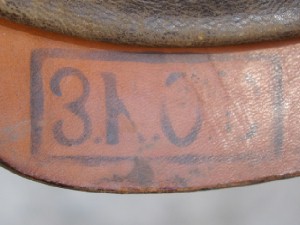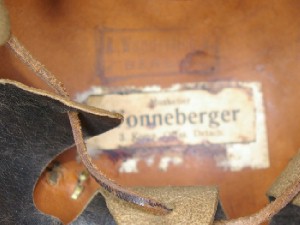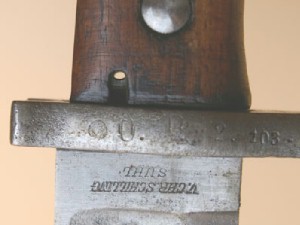|
This excellent collection shows items from
the German East Asian Expeditionary Corps, and its later reformations
the East Asian Occupation Brigade and the East Asian Detachment. These units
helped crush the 1900 Boxer Rebellion and then protected German interests in
China until 1909 with their
principal bases at Peking and Tientsin. The collection shows three
items, an other ranks spiked helmet ("Pickelhaube"), an
officers' sword and a pioneer's bayonet.
The Pickelhaube
The 1900 Pickelhaube of the East Asian Occupation Brigade was
authorised for wear in February 1901 and was unique in several ways.
Firstly rather than being made of blackened leather as were most
Pickelhauben of the German army, this was made of grey/green pressed
felt with front and rear peaks in green leather. To some extent it may
have been a test idea for the German command to produce cheaper and
more camouflaged headdress for the army in future. Certainly pressed
felt Pickelhauben came to be in common use during the First World War
when supplies of imported leather could not be obtained.
Secondly, as the East Asian Occupation
Brigade was an imperial unit rather than one nominally under state
command as was the regular army in Germany it has only imperial
insignia. This insignia takes the form of an imperial eagle in yellow
metal, and only an imperial cockade on the right hand chinstrap boss
(just visible in this photograph) and no cockade at all on the left
where the state cockade was usually displayed.
The third noticeable difference on most
East Asian Occupation Brigade Pickelhauben was vertically elongated
ventilation holes at the base of the spike. Interestingly this
Pickelhaube does not have such holes, instead having round holes as
usually worn on regular army Pickelhauben. It may be that only some
Pickelhauben had these elongated holes or that this one has a
replacement spike.
A fourth unique part to the East Asian
Brigade Pickelhaube not visible in this picture, was that it had a
small round metal lid that could fit over the spike hole when the
spike was removed. Again this appears to be a trial run for future
army use and Pickelhauben were regularly worn during the First World
War with the spike removed.
As with most uniform items, officers
usually purchased privately made Pickelhauben with better quality
materials. This helmet however appears to be a mass produced other
ranks version, probably issued to the infantry or cavalry. The East
Asian artillery wore a ball instead of a spike on their helmets, the
pioneers had a white metal eagle and the train company wore Jäger
style shakos also made of grey/green pressed felt.
The Officer's Sword
This is the standard model sword for an Infantry officer of the East
Asian Occupation Brigade, again notice it has imperial rather than
state insignia in the form of an imperial eagle on the hilt. Officers'
swords in the regular army usually bore state insignia such as a
Prussian Eagle, or a Bavarian Lion.
The Pioneer's Bayonet
The East Asian Pioneer bayonet was
of a unique model, the "Pionier-Faschinenmesser 98".
This bayonet pre-dates the other items in this collection by six months
or so. It looks like it was issued to the East Asian Expeditionary
Corps in the Summer of 1900, judging by its unit marking. It has the
marking "O.P.2.103." (see close up below) for the 2nd East
Asian Pioneer Company ("2.
Ostasiatische Pionier Kompanie"), weapon number 103. The 2nd and 3rd
Pioneer Companies were disbanded in May 1901.
 |
 |
 |
| An
illegible marking inside the Pickelhaube. |
Another
illegible marking inside the Pickelhaube. Please
contact me here if you can decipher either of these
markings (clicking on the image will give you a larger version of
these photographs). |
The
markings "O.P.2.103." on the Pioneer Bayonet |
| |
|
|
|